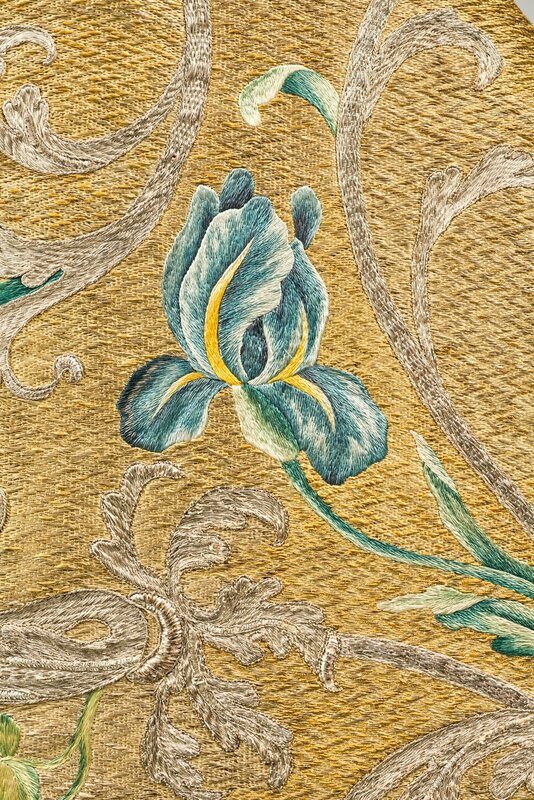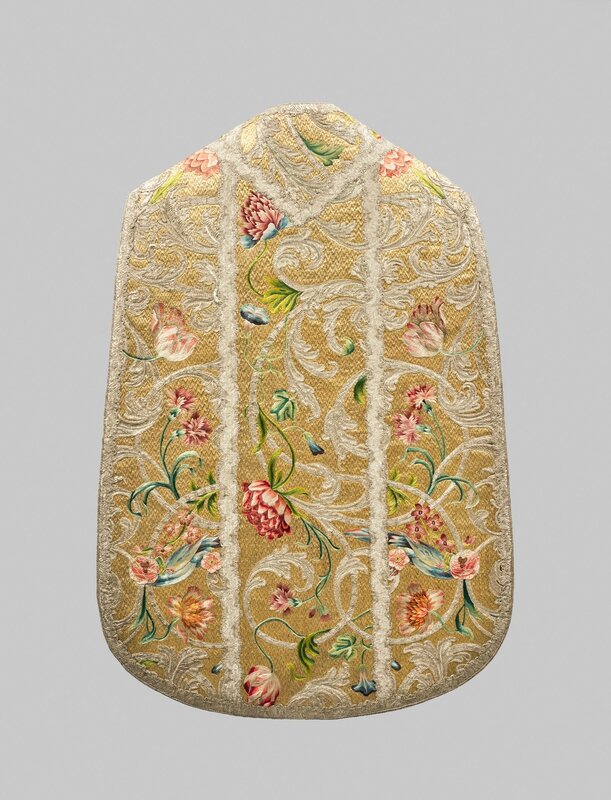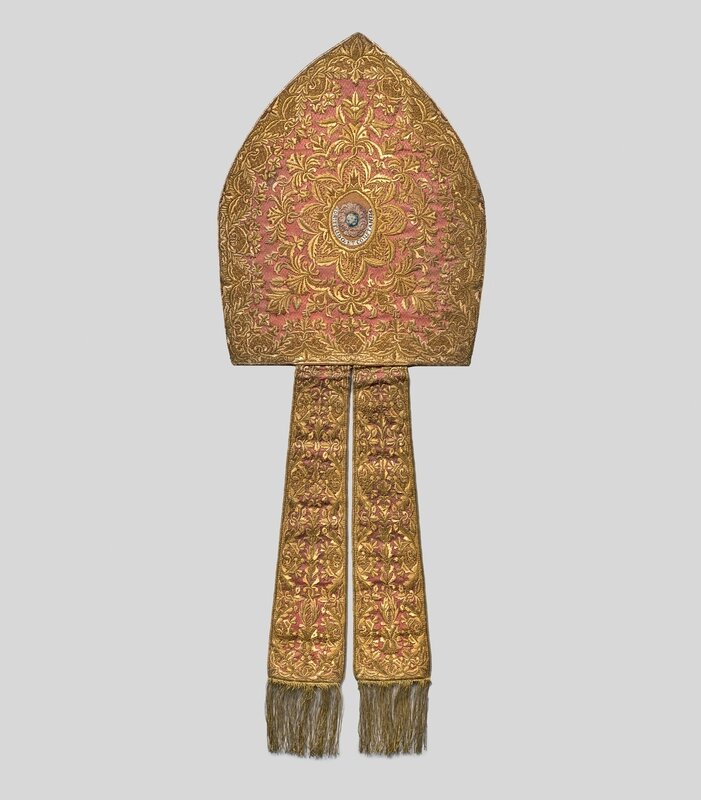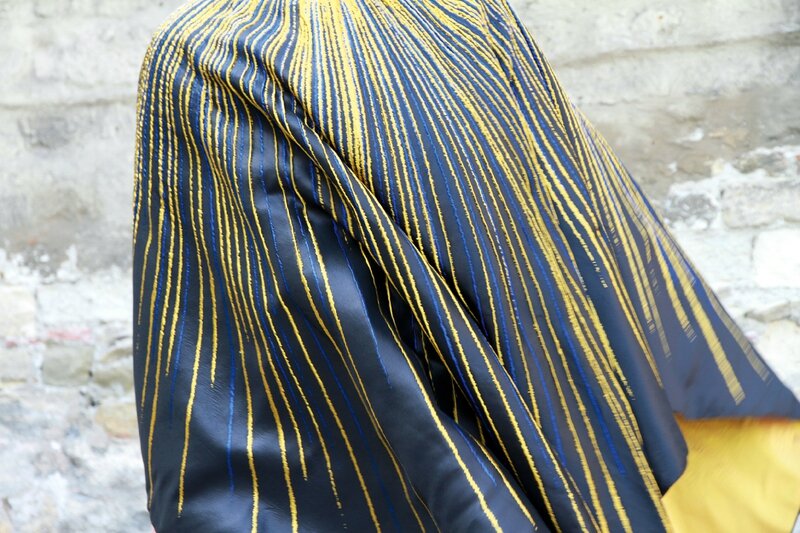Ecclesiastical textiles from the age of Maria Theresia on view in Vienna
VIENNA.- The Ecclesiastical Treasury house's important holdings of 18th-century liturgical vestments cannot be on permanent display for conservation reasons. The majority of these precious textiles were donated by Emperor Charles VI (1685-1740), his wife Elisabeth Christine (1691-1750) and their daughter Maria Theresia (1717-1780). At the time it was customary to use costly French or Italian fabrics, lavishly embellished with embroidery, for such vestments. Imperial robes were also occasionally reworked into such robes.
The exhibition offers insights into the wealth and exceptional quality of the Imperial Treasury’s holdings of precious vestments, which reflect the Pietas Austriaca, the deep piety of the House of Habsburg.
"Paperl" (parrots) Vestments: cope donated by Elisabeth Christines (1691–1750), the wife of Emperor Charles VI, produced in Vienna c. 1712/40; h. 157 cm, w. 304 cm © KHM-Museumsverband
"Paperl" (parrots) Vestments: cope (detail) donated by Elisabeth Christines (1691–1750), the wife of Emperor Charles VI, produced in Vienna c. 1712/40; h. 157 cm, w. 304 cm © KHM-Museumsverband
"Paperl" (parrots) Vestments: chasuble donated by Elisabeth Christines (1691–1750), the wife of Emperor Charles VI, produced in Vienna c. 1712/40; h. 157 cm, w. 304 cm © KHM-Museumsverband
The museum has also included a selection of contemporary ecclesiastical garments produced after designs by the artists Christof Cremer and Stephan Hann. They document the high standard liturgical vestments are still expected to meet today as they continue to form a seminal part of the celebration of Mass.
In connection with the exhibition, the museum has also decided to confront three modern copes produced after designs by Christof Cremer with historical vestments in a display installed in the so-called Paramentengang (vestment corridor) in the Ecclesiastical Treasury. This is the first time that contemporary art is displayed in the Treasury since it was newly installed and reopened in the 1980s.
Black Ladies-Vestments: chasuble donated by Maria Theresia (1717–1780), produced in Vienna, 1776; h. 106 cm, w. 72 cm © KHM-Museumsverband
Black Ladies-Vestments: chasuble donated by Maria Theresia (1717–1780), produced in Vienna, 1776; h. 106 cm, w. 72 cm © KHM-Museumsverband
FOR THE GLORY OF GOD
The extensive holdings of the Ecclesiastical Treasury in Vienna are largely unknown to the general public; they comprise mainly vestments and liturgical textiles that were used to celebrate Mass or during religious festivities. Totalling around 1.700 artefacts, the collection includes both sets of vestments and individual textiles. Many of these precious garments were donated by members of the House of Habsburg who for centuries ruled the Holy Roman Empire. The pomp and circumstance associated with this high office is reflected in the costliness of these sumptuous textiles, the finest of which date from the Baroque, the apogee of Habsburg piety. Unlike mediaeval ecclesiastical textiles, baroque vestments generally feature not figurative but purely ornamental decorations. Precious secular silks adorned with a variety of designs frequently function as the base material, which is then elaborately embellished with appliqués, lace or gold-, silver- and silk embroidery to produce opulent textile works of art.
"Coat-Dress" Vestments: chasuble donated by Maria Theresia (1717–1780), produced in Vienna, 2nd half of the 18th century; h. 106 cm, w. 75 cm © KHM-Museumsverband
"Blue Vestments": chasuble donated by Maria Theresia (1717–1780), produced in Vienna, 1778; h. 106 cm, w. 73 cm © KHM-Museumsverband
"Blue Vestments": chasuble (detail) donated by Maria Theresia (1717–1780), produced in Vienna, 1778; h. 106 cm, w. 73 cm © KHM-Museumsverband
The leading benefactress in the 18th century was Maria Theresia (1717-1780). She donated precious textiles for use in the imperial palace chapel and the chapels of the different imperial summer residences at Schönbrunn, Laxenburg and Hetzendorf, as well as in St. Augustine’s church in Vienna. The latter evolved into a major stage for Habsburg piety. Here newly-appointed bishops were invested. All these places were lavishly appointed with sumptuous ecclesiastical textiles.
Contemporary sources clearly document the seminal role played by high-quality vestments during the Baroque. Many of these artefacts have been preserved in the Ecclesiastical Treasury because of their preciousness and the prominent benefactors who donated them. A selection is on show in this exhibition.
Mitra donated by Emperor Charles VI (1685–1740), produced in Vienna (?), 1712/40; h. 77 cm, w. 30 cm © KHM-Museumsverband
Black chasuble design: Christof Cremer (*1969), produced in Germany, 2014; h. 135 cm, w. 155 cm, Priest Hans Stieler, Cologne © Paramentenhaus Wefers, Cologne.
Black chasuble design: Christof Cremer (*1969), produced in Germany, 2014; h. 135 cm, w. 155 cm, Priest Hans Stieler, Cologne ©Julia Oppermann

/https%3A%2F%2Fprofilepics.canalblog.com%2Fprofilepics%2F1%2F0%2F100183.jpg)
/https%3A%2F%2Fstorage.canalblog.com%2F03%2F02%2F119589%2F96711876_o.jpg)
/https%3A%2F%2Fstorage.canalblog.com%2F11%2F31%2F119589%2F94773502_o.jpg)
/https%3A%2F%2Fstorage.canalblog.com%2F20%2F83%2F119589%2F94772815_o.jpg)
/https%3A%2F%2Fstorage.canalblog.com%2F26%2F72%2F119589%2F75604929_o.jpg)
/https%3A%2F%2Fstorage.canalblog.com%2F59%2F60%2F119589%2F26458628_o.jpg)














/image%2F1371349%2F20240418%2Fob_ac5c4c_telechargement.jpg)
/image%2F1371349%2F20240418%2Fob_709b64_304-1.jpg)
/image%2F1371349%2F20240418%2Fob_22f67e_303-1.jpg)
/image%2F1371349%2F20240417%2Fob_9708e8_telechargement.jpg)